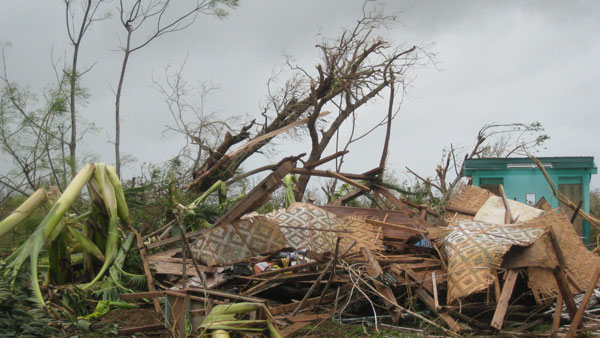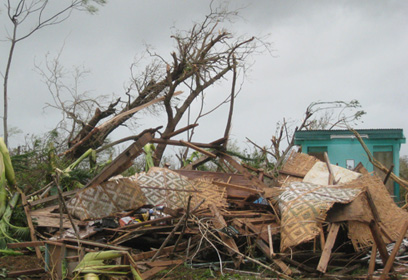
When you let go after taking someone’s pulse, it is hard not to feel your own. Three years after her postmodern translation of Dante’s Inferno, Mary Jo Bang conjures her own hell—and we recognize it as ours. Her seventh collection of poems, The Last Two Seconds, is littered with terrible omens, from cockroaches to bleeding dolls to the Doomsday Clock itself. Ruins and dead things tick us toward the end of time. There are no Virgils here. Instead, the cockroaches of the first poem, “The Earthquake She Slept Through,” point the way toward the future: “the dead / antennae announced the future by pointing to the silver mouth // that would later gulp the water she washed her face with.” This is our fate, a quintessential Bang remix of we are going down the drain.
In a 2013 essay on why she writes, Bang uses the metaphor of the Tetris effect to explain how she organizes all perceptual experience around her impulse to make a poem: “Apparently, after playing the game for a time, some people even begin to perceive of the visual world as consisting of interlocking shapes.” For Bang, all perception is the beginning of her own act of artifice. Her braiding of registers and references is not an aesthetic preference so much as a mode of perception. Her work is simultaneously traditional and experimental, melding canonical references with allusions to popular culture in forms that range from tercets to numbered fragments. Categorizing Bang’s work starts to look like a magic handkerchief trick. In her verse-novel Louise in Love (2001), she devises a cinematic drama of silent movie star Louise Brooks’s imagined love life. In The Eye Like a Strange Balloon (2004), Bang responds to visual art by transforming its power in a verbal medium. In her 2007 National Book Critics Circle Award–winning Elegy, she approaches the loss of her son in an effort to construct, rather than capture, a language of unspeakable grief. Bang moves from silent film to visual culture to her own psychological trauma, her impulse to write poetry one of translating the non-linguistic into language.
Where time itself is under siege, uncertainty figures as the only metronome.
Bang is not unique in translating perceptual experience into poetry, but where a poet such as Jorie Graham is interested in recording the experience of a moment, Bang is more interested in constructing a perceptual experience for what is no longer perceptible. Imagining a depleted world becomes a hellish translation of our moment. Reading these poems is like tasting some bitter cousin of cotton candy, the way the wispy sugar becomes denser and darker as it dissolves. The poems read like dress rehearsals for the apocalypse, with a mood of anxiety and urgent self-consciousness. In the shortest poem in the book, the interrogative for not knowing the reason or purpose repopulates the uncertain world:
We put you in the circus. Was that a good idea? And now
there are so few of you. Why why why why why?
Why why why why why why?
The difficulty of these poems is not one of puzzling out but one of keeping up. In a book where time itself is under siege, uncertainty figures as the only metronome.
The Last Two Seconds is Bang’s most intensely metaphysical collection. The poems colonize abstraction—“Equidistant from the Center of Never,” “An Autopsy of an Era,” “The Blank of Reason Produces Blank: After Goya”—while remaining as formally rigorous and particular as her earlier work. The poems consider the relationship between our destructive actions and the concepts of time and space. Just as Bang deftly blurs cultural and linguistic registers, her wild, multipart similes layer abstraction into image:
Any disquiet, however slight, might
define a moment like a character’s obsessive cough
might define a character by exploding
when it shouldn’t. It keeps exploding
and when it does it acts in the story
like a glass box cracked by a hammer that breaks
and becomes a broken box.
Notice the artfully wrong use of like for as, drawing attention to the way an image can propel thought (when a verb follows) rather than merely represent thought (as a noun). Throughout the collection, the poems present both the self and the world as moveable parts, magnets that ruin and rely on each other, repel and attract uncontrollably. The reader never knows when Bang will deliver a moment of iron grab or a force field of resistance.
In previous collections Bang’s poems often moved from mystery to a slant but determinate revelation. Here the poems are more porous, more continuous in their sequence while gravitating toward uncertainty. Each one begins with a kind of finality that seems to inhibit its trajectory, and it is this tension of opening with closures that makes the poems most thrilling. Take “Equidistant from the Center of Never,” which opens, “The door closed on the self she had been and / the outside went soft.” After taking us through a series of devastations—a car veering off a cliff, “a mountain melting,” an electric fire—the poem lands in a space between what deafens and what silences: “a tornado continually mimed a bluster on one side / or the other of the audible. Everything lasted a second.” Beginning with a view of what is over, what is last becomes what lasts.
Bang has experimented with ventriloquism and personae throughout her career, but in this enduring world of doppelgangers and dolls, her experiments with voice lead to a darker and more intimate confrontation with her own personality. Paradoxically, the poems that move away from an “I”—through characters or appropriated language—reveal the self in a kind of black-light clarity of terror and embarrassment. With the use of the voyeuristic third person, the self-reflective second person, and the ambiguous “we,” the poems deepen her introspection through their distance. Tapping into historical trauma, the poems turn public even as they become more transparently personal. Responding to sources as diverse as Kafka, Goya, Pussy Riot, Cleopatra, and Kubrick, Bang constructs a new world out of the culture we are destroying. In a world we are obliterating through surveillance, climate change, and war, it is the dead’s turn to perform CPR on our historical moment.
The tour de force of the collection is the six-part “Let’s Say Yes,” which takes its language from Virginia Woolf’s Mrs Dalloway. Metacognitive and lyrically pleasurable, the poem draws its diction entirely from corresponding sections of the novel. The first opens with perception becoming cognition: “I love pictures. Scene after scene / shooting to a brain. Messages on waves. / But suddenly, in the middle of day, an arrow / like a knife through a perpetual instant.” Bang’s enjambments let the reader feel the severing of time (line breaks) during the synthesis of meaning (ongoing syntax). As image winds into thought and thought winds into time, the lineation turns each section into a wind-up cognitive clock the reader must activate even before she can make sense of the sentence. The world may be bleak, but “Let’s Say Yes” is an affirmation of thinking in spite of it all:
Exactly, thought. Here she is having a mind,
a moon ghastly light on a person. To suffer
emotion, throat stiff, child grown larger.
A whole. Summoned so one can have a look.
Summoned to husband what’s happened.
The light challenged the powers
of feeling: frightening, exhilarating, surprise,
shame. It was over. Plaster and litter alone.
Five acts that had been.
Over and over. A strange power speaking.
Some concern for the half-past. Ring after ring
like something coming. It is thought,
this bell like a bee striking.
The future lies in a patter like a wood drummed.
A sensual traffic: what, where, and why.
Here is Woolf’s original stream of consciousness manipulated to question consciousness. The tone is desolate—“It was over”—but the finality of the end of the world is turned through repetition into proof of its continuation: “Over and over.” The disorientation is illuminating, the way the phenomenon of white nights might cause confusion about what is perpetual and what is illuminated in passing. Amid the litter, language materializes into thought in a complex metaphor-simile hybrid: “It is thought, this bell like a bee striking.” The bell of thought sounds the alarm of mortality like a honeybee whose sting extinguishes itself, the pollinator now facing extinction.
On January 23, 2015, the hands of the Doomsday Clock were moved two minutes closer to midnight. As the bleak prognosis of the title The Last Two Seconds suggests, we have just enough time before the end to realize it is the end. Time takes on an uncanny feeling of something still alive with you, like a roach, not dead but scuttling in the sink. In “The Numbers,” the speaker revises the seven sins, which range from greed to big cars to war, concluding with “suicide for seven / when it kills more than one.” Acts of self-destruction vex and fascinate Bang because they are suicide for our collective humanity.
In “A Technical Drawing of the Moment,” Bang questions her impulse to mythologize such devastation:
What is myth? and further, is it better
to dispel or debunk one, or instead should we embrace the petty mechanistic
hope that invents it? Are we not ridiculous,
torn in two between the true
and what we’d so like to believe is true?
Bang devises a myth for what we’d like to believe is not true, a destruction myth that dissects the truth of our moment. At the end of the poem, the speaker characterizes history as “our keeper and contentious tormentor.” “We” are collectively the tormentors and keepers of history. Even though time is running out, the very momentum that runs through the poems is evidence of the urgency to write history down.
The collection opens with sleeping through a natural disaster, but by the last poem, the speaker is wide awake to human disaster, voyeur to the anesthetization of others. For some, feeling more awake, even alive, in the face of doom is little compensation—it might make the end more painful. But for those of us who live in language, this book is as much a paean to art as a laying of blame. Not all art has the power to sustain hope, but Bang’s cynical art increases our awareness of our moment in time and the way our thinking shapes our world, even a dystopian one. Watching our physical and metaphysical infrastructures crumble, Bang still chooses to be awake when there is no hope. In a book so anxious about the end of history, Bang offers us the paradox that by having language, recycling and writing it, history is inevitably still happening. There are signs at the end of the world, and she is the metaphysician with a scalpel.
Kafka, one of the fore-ghosts of this collection, wrote, “You can hold yourself back from the sufferings of the world, that is something you are free to do and it accords with your nature, but perhaps this very holding back is the one suffering you could avoid.” Mary Jo Bang’s first six books focus on the conflicts of the interior, but now she refuses to hold back from the surrounding inferno of earthquakes, tornadoes, climate change, racism, sexism, and surveillance. In The Last Two Seconds, the advantage of hopelessness is that we can feel it.








